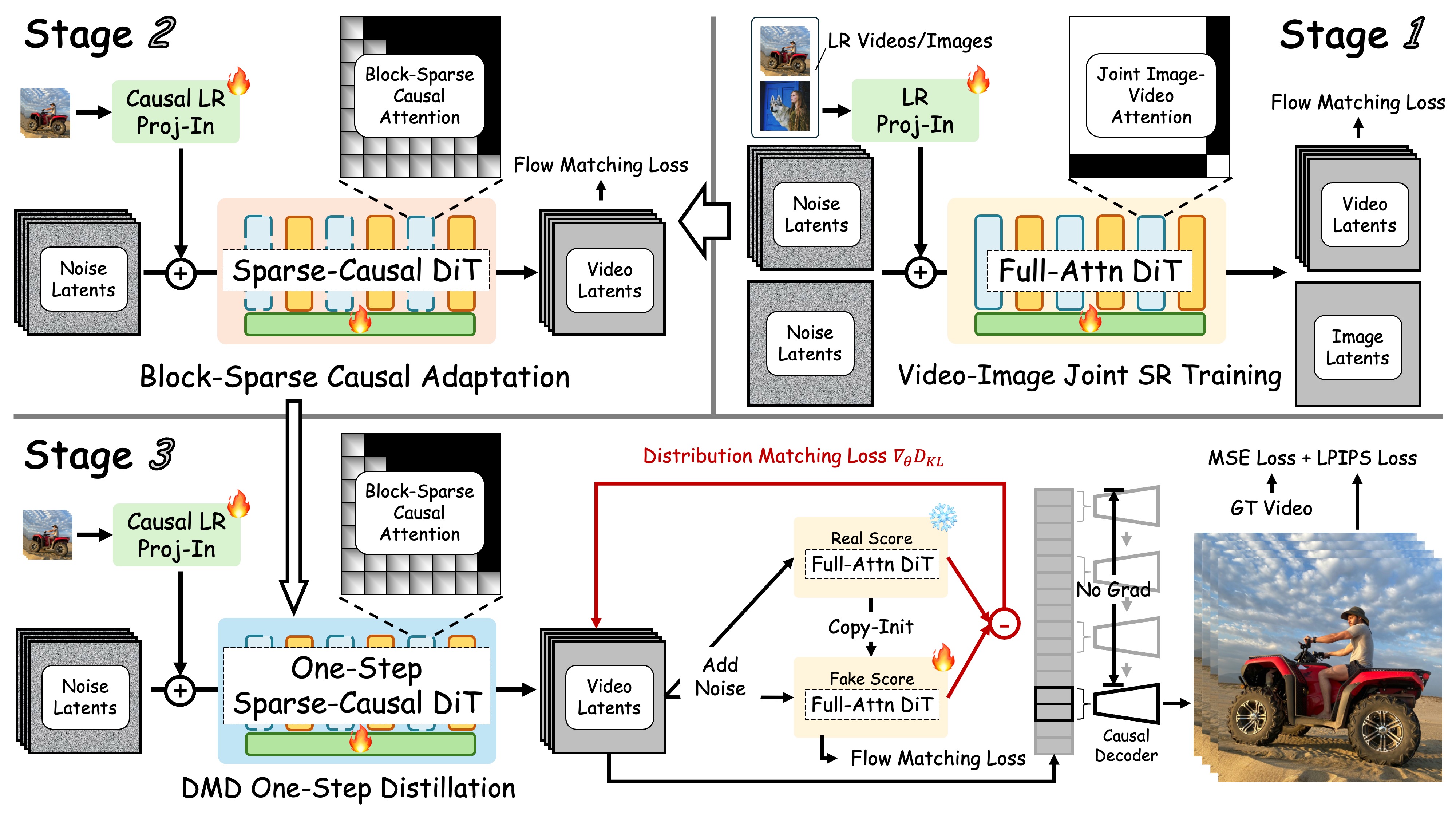license: apache-2.0
pipeline_tag: video-to-video
⚡ FlashVSR
Towards Real-Time Diffusion-Based Streaming Video Super-Resolution
Authors: Junhao Zhuang, Shi Guo, Xin Cai, Xiaohui Li, Yihao Liu, Chun Yuan, Tianfan Xue
Your star means a lot for us to develop this project! :star:

🌟 Abstract
Diffusion models have recently advanced video restoration, but applying them to real-world video super-resolution (VSR) remains challenging due to high latency, prohibitive computation, and poor generalization to ultra-high resolutions. Our goal in this work is to make diffusion-based VSR practical by achieving efficiency, scalability, and real-time performance. To this end, we propose FlashVSR, the first diffusion-based one-step streaming framework towards real-time VSR. FlashVSR runs at ∼17 FPS for 768 × 1408 videos on a single A100 GPU by combining three complementary innovations: (i) a train-friendly three-stage distillation pipeline that enables streaming super-resolution, (ii) locality-constrained sparse attention that cuts redundant computation while bridging the train–test resolution gap, and (iii) a tiny conditional decoder that accelerates reconstruction without sacrificing quality. To support large-scale training, we also construct VSR-120K, a new dataset with 120k videos and 180k images. Extensive experiments show that FlashVSR scales reliably to ultra-high resolutions and achieves state-of-the-art performance with up to ∼12× speedup over prior one-step diffusion VSR models.
📰 News
- Nov 2025 — 🎉 FlashVSR v1.1 released: enhanced stability + fidelity
- Oct 2025 — FlashVSR v1 (initial release): Inference code and model weights are available now! 🎉
- Bug Fix (October 21, 2025): Fixed
local_attention_maskupdate logic to prevent artifacts when switching between different aspect ratios during continuous inference. - Coming Soon: Dataset release (VSR-120K) for large-scale training.
📢 Important Quality Note (ComfyUI & other third-party implementations)
First of all, huge thanks to the community for the fast adoption, feedback, and contributions to FlashVSR! 🙌
During community testing, we noticed that some third-party implementations of FlashVSR (e.g. early ComfyUI versions) do not include our Locality-Constrained Sparse Attention (LCSA) module and instead fall back to dense attention. This may lead to noticeable quality degradation, especially at higher resolutions.
Community discussion: https://github.com/kijai/ComfyUI-WanVideoWrapper/issues/1441
Below is a comparison example provided by a community member:
| Fig.1 – LR Input Video | Fig.2 – 3rd-party (no LCSA) | Fig.3 – Official FlashVSR |
|---|---|---|
✅ The official FlashVSR pipeline (this repository):
- Better preserves fine structures and details
- Effectively avoids texture aliasing and visual artifacts
We are also working on a version that does not rely on the Block-Sparse Attention library while keeping the same output quality; this alternative may run slower than the optimized original implementation.
Thanks again to the community for actively testing and helping improve FlashVSR together! 🚀
📋 TODO
- ✅ Release inference code and model weights
- ⬜ Release dataset (VSR-120K)
🚀 Getting Started
Follow these steps to set up and run FlashVSR on your local machine:
⚠️ Note: This project is primarily designed and optimized for 4× video super-resolution.
We strongly recommend using the 4× SR setting to achieve better results and stability. ✅
1️⃣ Clone the Repository
git clone https://github.com/OpenImagingLab/FlashVSR
cd FlashVSR
2️⃣ Set Up the Python Environment
Create and activate the environment (Python 3.11.13):
conda create -n flashvsr python=3.11.13
conda activate flashvsr
Install project dependencies:
pip install -e .
pip install -r requirements.txt
3️⃣ Install Block-Sparse Attention (Required)
FlashVSR relies on the Block-Sparse Attention backend to enable flexible and dynamic attention masking for efficient inference.
⚠️ Note:
- The Block-Sparse Attention build process can be memory-intensive, especially when compiling in parallel with multiple
ninjajobs. It is recommended to keep sufficient memory available during compilation to avoid OOM errors. Once the build is complete, runtime memory usage is stable and not an issue.- Based on our testing, the Block-Sparse Attention backend works correctly on NVIDIA A100 and A800 (Ampere) with ideal acceleration performance, and it also runs correctly on H200 (Hopper) but the acceleration is limited due to hardware scheduling differences and sparse kernel behavior. Compatibility and performance on other GPUs (e.g., RTX 40/50 series or H800) are currently unknown. For more details, please refer to the official documentation: https://github.com/mit-han-lab/Block-Sparse-Attention
# ✅ Recommended: clone and install in a separate clean folder (outside the FlashVSR repo)
git clone https://github.com/mit-han-lab/Block-Sparse-Attention
cd Block-Sparse-Attention
pip install packaging
pip install ninja
python setup.py install
4️⃣ Download Model Weights from Hugging Face
FlashVSR provides both v1 and v1.1 model weights on Hugging Face (via Git LFS).
Please install Git LFS first:
# From the repo root
cd examples/WanVSR
# Install Git LFS (once per machine)
git lfs install
# Clone v1 (original) or v1.1 (recommended)
git lfs clone https://huggingface.co/JunhaoZhuang/FlashVSR # v1
# or
git lfs clone https://huggingface.co/JunhaoZhuang/FlashVSR-v1.1 # v1.1
After cloning, you should have one of the following folders:
./examples/WanVSR/FlashVSR/ # v1
./examples/WanVSR/FlashVSR-v1.1/ # v1.1
│
├── LQ_proj_in.ckpt
├── TCDecoder.ckpt
├── Wan2.1_VAE.pth
├── diffusion_pytorch_model_streaming_dmd.safetensors
└── README.md
Inference scripts automatically load weights from the corresponding folder.
5️⃣ Run Inference
# From the repo root
cd examples/WanVSR
# v1 (original)
python infer_flashvsr_full.py
# or
python infer_flashvsr_tiny.py
# or
python infer_flashvsr_tiny_long_video.py
# v1.1 (recommended)
python infer_flashvsr_v1.1_full.py
# or
python infer_flashvsr_v1.1_tiny.py
# or
python infer_flashvsr_v1.1_tiny_long_video.py
🛠️ Method
The overview of FlashVSR. This framework features:
- Three-Stage Distillation Pipeline for streaming VSR training.
- Locality-Constrained Sparse Attention to cut redundant computation and bridge the train–test resolution gap.
- Tiny Conditional Decoder for efficient, high-quality reconstruction.
- VSR-120K Dataset consisting of 120k videos and 180k images, supports joint training on both images and videos.

🤗 Feedback & Support
We welcome feedback and issues. Thank you for trying FlashVSR!
📄 Acknowledgments
We gratefully acknowledge the following open-source projects:
- DiffSynth Studio — https://github.com/modelscope/DiffSynth-Studio
- Block-Sparse-Attention — https://github.com/mit-han-lab/Block-Sparse-Attention
- taehv — https://github.com/madebyollin/taehv
📞 Contact
- Junhao Zhuang Email: [email protected]
📜 Citation
@misc{zhuang2025flashvsrrealtimediffusionbasedstreaming,
title={FlashVSR: Towards Real-Time Diffusion-Based Streaming Video Super-Resolution},
author={Junhao Zhuang and Shi Guo and Xin Cai and Xiaohui Li and Yihao Liu and Chun Yuan and Tianfan Xue},
year={2025},
eprint={2510.12747},
archivePrefix={arXiv},
primaryClass={cs.CV},
url={https://arxiv.org/abs/2510.12747},
}


-blue)
-blue)

